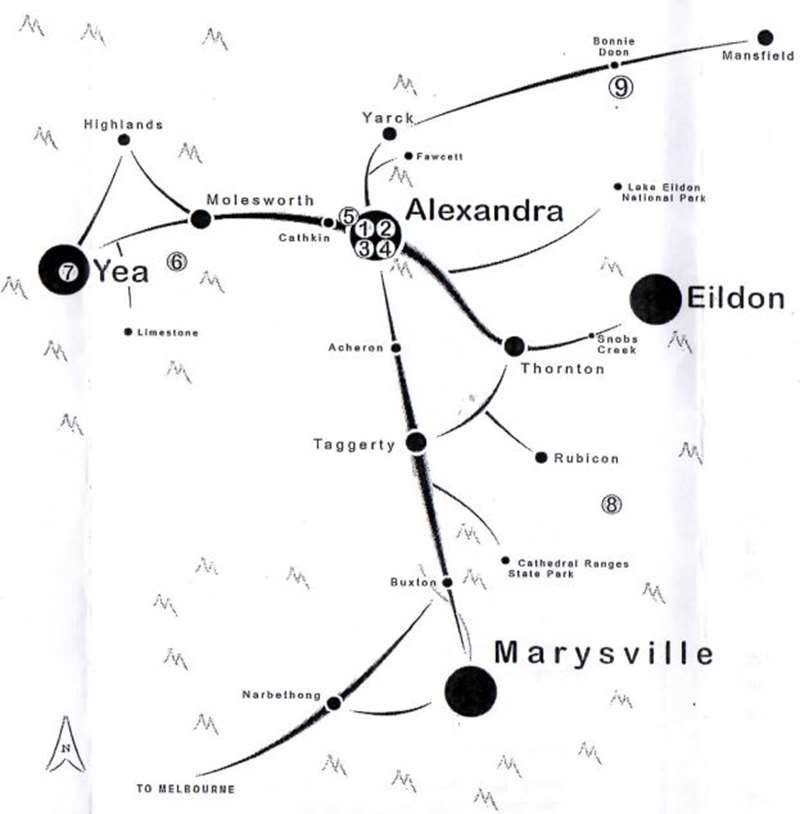Murrindindi District Historic Rail Sites

The districts has significant history in rail, both from the use of rail to transport timber from high up in the ranges to the mills and the main rail line from Melbourne used up until the mid 1970's to transport goods and people in and out of the district.
During the early to mid 1900's rail played a vital economic and social role in the district with two complete rail systems running to support different industries.
Both had their own infrastructure and distinct purposes and each used their own distinctive sized rail line.
The main rail system connected the district with the main centres like Melbourne and Mansfield which was used for transporting of goods and people. The district had many rail stations including many that have now all but disappeared like Koriella, Cathkin, Yarck, Molesworth, Merton, Bonnie Doon and Yea.
The second rail system was known as the Timber Tramway and brought timber from the ranges to the local timber mills where it was processed and prepared for sale.
Entire communities lived high up in the ranges to support the timber industry and they lived through many setbacks, with the largest being the devastating 1939 bush fires which claimed the lives of many members of the timber community.
The most significant timber tramways in the district were set in the forests near Rubicon, Marysville and Yea.
Today there is little left of the main rail system due to the stripping and consequent sale of the rail lines and bulk metal components as scrap metal by the financially broke Cain/Kirner Labour Government in the 1980's and early 1990's.
The Timber Tramway has now largely been lost with most of the rail being removed in the low lands, though sections have survived in the Rubicon Ranges where it can still be seen.
The Alexandra Timber Tramway is now the largest surviving museum of the districts Timber Tramway history as well as hosting the districts largest collection of Rail memorabilia and hardware for viewing. You can even take the kids on a Timber Tramway ride for their enjoyment.
Map of Historic Rail Sites

1. ALEXANDRA HISTORIC RAILWAY STATION

The Alexandra Timber Tramway Museum offers a fully functional Timber Tramway for your family to ride on as well as a museum and the Station its self.
Location: Station Street, Alexandra
2. EGLINGTON RAIL BRIDGE

Now a proud part of the Great Victorian Rail Trail, that extends from Tallarook, to Mansfield and Alexandra.
Location: 1.5km NW of Alexandra Timber Tramway Museum along Great Victorian Rail Trail.
3. EGLINTON RAILWAY CUTTING LOOKOUT
Experience the view that train commuters would have seen after exiting the Eglington Railway Cutting.
Location: 1.5km NW of Alexandra Timber Tramway Museum along Great Victorian Rail Trail.
4. OLD TRESTLE BRIDGE REMAINS One of three rail trestle bridges on the 6km stretch of road between the Koriella turnoff and Cathkin. It is in poor condition, though is still interesting to see. See if you can find all three historic trestle bridges (includes the Spring Creek bridge).
Location: 6km stretch of road between the Koriella turnoff and Cathkin
5. SPRING CREEK RD TRESTLE BRIDGE REMAINS
One of three rail trestle bridges on the 6km stretch of road between the Koriella turnoff and Cathkin. This one is at the Spring Creek bridge just before Cathkin.
Location: Spring Creek bridge just before Cathkin
6. CHEVIOT TUNNEL

An amazing old rail tunnel that was also a part of a road network up until 2012. Cheviot Tunnel is one of the few historic railway tunnels that you can walk or ride through.
Location: Cheviot Road, Limestone
7. YEA HISTORIC RAILWAY STATION

The Yea Railway Station in Yea is a great example of our railway heritage. Walk the platform, enjoy the shops or have a BBQ or toilet break. It is well worth a look.
Location: Railway Street, Yea
8. 15000 SYPHON BRIDGE
Located high in the Rubicon Ranges, this is one of the few remaining trestle bridges that supported the timber industry and the associated railway system in the ranges.
9. BONNIE DOON RAIL WALKING BRIDGE

The Bonnie Doon Rail Bridge is now Victoria's longest converted walking bridge of its kind and offers an amazing view and experience.









